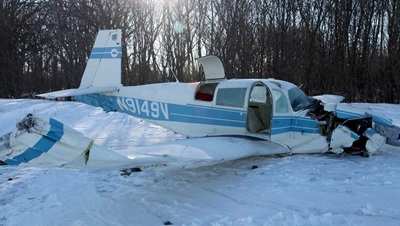Surviving the Wait
Safety SPOTLIGHT: Survive

We’re often told the three keys to survival in any scenario are water, protection from the elements, and food. The most critical factor, however, is your attitude. Much of the time waiting for rescue involves doing nothing, which can dull the senses and make you less aware of your surroundings or incipient threats. The longer you remain in good spirits, the better your ability to make good decisions and stay alert. Little comforts stashed in your survival vest, like a toothbrush, toilet paper, candies, or a deck of cards, can make a huge difference in keeping a positive attitude and staying focused.
There I Was: Dan Bass
 In this episode, we talk to Minnesota-based pilot Dan Bass. While flying his Mooney on a return trip from Ontario, Dan experienced carbon monoxide poisoning and lost consciousness while airborne. Hear Dan’s incredible story of survival as he wakes up in a snow-covered field in the bitter February cold.
In this episode, we talk to Minnesota-based pilot Dan Bass. While flying his Mooney on a return trip from Ontario, Dan experienced carbon monoxide poisoning and lost consciousness while airborne. Hear Dan’s incredible story of survival as he wakes up in a snow-covered field in the bitter February cold.
Water
A lack of water is a universal threat to survival, particularly in cold weather where signs of dehydration can be easily overlooked. Drinkable water must be found within 24 hours after a forced landing or your survival could depend on your cleverness at extracting water from plants, wet materials, or condensation.
Eating snow is usually not a good option because hypothermia from the metabolic drain to your body adds another risk to compete with dehydration. In the absence of any other water source, however, it may be your only option. It is far easier to carry an extra gallon or two in the airplane for every individual aboard the aircraft—ideally, a day’s supply for each person.
A lack of water is a universal threat to survival, particularly in cold weather where signs of dehydration can be easily overlooked.
If you find a source of running water, it is generally a good idea to treat it to remove anything that could harm you like protozoa, bacteria, and viruses. Boiling water is the classic option for producing safe drinking water. It has drawbacks, though—it uses fuel, time, and resources—but in the event of a cold-climate forced landing, it may be the best or only means of obtaining drinkable water, particularly from snow or ice.
The most inexpensive portable treatment systems are halogen-based water purifying tablets, usually made of chlorine or iodine. Filters can also be effective. A more potent option is ultraviolet light, but it requires electricity, so it will only work as long as there are batteries or a charge.
Protection from the Elements
Fire, clothing, and shelter are all critical protections against the elements. Fire is indispensable for signaling, protection against weather and critters, staying warm, boiling water, or melting snow. But natural fuel is not a guarantee at a forced landing site, especially in a cold weather environment. A small package of fire starter can be stored in your vest. A small stove is even better, but will likely have to go in a survival kit.
There is an adage among mountaineers that there is “no such thing as bad weather, only bad gear.” Before starting your flight, ask yourself if you are dressed for the terrain and weather you are flying over. Synthetic pile, wool, and comfort are your allies. Cotton clothing is generally a liability because of its poor insulating ability when wet (it tends to trap moisture next to skin). A hat, gloves, and multiple thin layers, including a wind and waterproof outer shell, are adaptable to most weather situations and allow you to be more productive in accomplishing survival tasks. For hot weather, protection from the sun is critical. Consider sun-protecting clothing, hats, sunscreen, lip protection, and potentially a tarp for shade.
Don’t forget your extremities. Cold weather survival requires functioning hands and feet. Wearing proper socks and reliable footwear when you depart means you will have the right shoes on for your rescue. Gloves and a hat can be stored in your vest. Consider carrying neoprene gloves if you are flying over water.
Shelter provides protection from the elements, protects supplies, and lengthens survival times. The ideal shelter is a lightweight emergency pocket shelter or specialized low-profile hammock tent. Paracord and a large sheet of waterproof material can be a fine substitute and can also be stored in your survival vest. It is best to carry both options if able. If your large tarp or tent in the back of the plane survives the forced landing, you can use your extra waterproof sheets to collect water or keep your gear dry.
Food
Humans can survive a long time without food, but sustenance improves our decision making and provides more energy for other survival tasks. Packing high-calorie items such as protein bars, seeds, jerky, and candy will help keep you focused and rational. This is especially important if you are unskilled at hunting, fishing, or foraging for vegetation, or have the skills but are not carrying the proper equipment. When your food is limited, be mindful of preserving your energy and limiting exertion to priority activities that have a tangible survival benefit. Don’t hesitate to rest and recover. You won’t need to exert yourself much if you follow the guidelines—SAGA—and stay with the forced landing site if practical. Even a crash site that’s visible from the air might be inaccessible to rescuers, and if for some reason travel or exertion is warranted, you will need the energy.